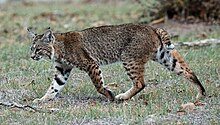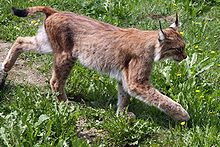Lynx
Lynx is any of the four genus species of medium-sized wildcats. The name "lynx" originated in Middle-English via Latin from Greek word "lunx", derived from the Indo-European root "*leuk-", meaning "light, brightness", in reference to the luminescence of its reflective eyes. There is considerable confusion about the best way to classify felids at present, and some authorities classify them as part of the genusFelis. The caracal, despite sometimes being called Persian lynx or African lynx, does not belong to this genus.
Appearance
Lynx have short tails and characteristic tufts of black hair on the tip of their ears.They have a ruff under the neck, which has black bars (not very visible), resembling a bow tie. They have large padded paws for walking on snow, and long whiskers on the face.
The large body colour varies from medium brown to gold-ish to beige-white; and occasionally, is marked with dark brown spots, especially on the limbs. All species of lynx also have white fur on their chests, bellies and on the insides of their legs, which are extensions of the chest and belly fur. Also, the lynx's colouring, fur height and paw size varies by its climate range—in the Southwestern United States, the fur and colour are short-haired, dark and the paws are smaller and less padded; as the lynx ranges to its colder northern climates, the fur gets progressively thicker (for warmth), the colour gets lighter (for camouflage) and its paws enlarge and become more padded (for snowy environments). Their paws may become larger than a human hand or foot.
They have extremely good hearing and have 28 teeth, which stab deeply into their prey. This can be especially helpful to the lynx because they are not the most efficient hunters and they lose most of their prey to a variety of factors.
The smallest species are the bobcat and the Canada lynx, while the largest is the Eurasian lynx, however there are considerable variations within species.




